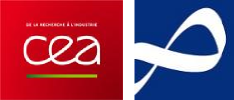Challenges in focal plane and telescope calibration for high-precision space astrometry
Résumé
With sub-microarcsecond angular accuracy, the Theia telescope will be capable of revealing the architectures of nearby exoplanetary systems down to the mass of Earth. This research addresses the challenges inherent in space astrometry missions, focusing on focal plane calibration and telescope optical distortion. We propose to assess the future feasibility of large-format detectors (50 to 200 megapixels) in a controlled laboratory environment. The aim is to improve the architecture of the focal plane while ensuring that specifications are met. The use of field stars as metrological sources for calibrating the optical distortion of the field may help to constrain telescope stability. The paper concludes with an attempt to confirm in the laboratory the performance predicted by simulations. We will also address the possibility of using such techniques with a dedicated instrument for the Habitable World Observatory.
Fichier principal
 theia-spie2024 (1).pdf (6.91 Mo)
Télécharger le fichier
Fig2_distorted_grid.pdf (1.42 Mo)
Télécharger le fichier
Fig3_Field_modified.pdf (40.05 Ko)
Télécharger le fichier
Fig4_evolution_residuals.pdf (20.12 Ko)
Télécharger le fichier
THEIA_spie_2024.pdf (14.66 Mo)
Télécharger le fichier
classical-detector-calibration-curves.jpg (369.8 Ko)
Télécharger le fichier
classical-detector-calibration.jpg (941.83 Ko)
Télécharger le fichier
diag-mass-vs-radius.jpg (797.47 Ko)
Télécharger le fichier
distortion-calibration-bench.jpg (382.24 Ko)
Télécharger le fichier
theia-spie2024.pdf (6.94 Mo)
Télécharger le fichier
ups-and-dss2-colored.png (3.13 Mo)
Télécharger le fichier
theia-spie2024 (1).pdf (6.91 Mo)
Télécharger le fichier
Fig2_distorted_grid.pdf (1.42 Mo)
Télécharger le fichier
Fig3_Field_modified.pdf (40.05 Ko)
Télécharger le fichier
Fig4_evolution_residuals.pdf (20.12 Ko)
Télécharger le fichier
THEIA_spie_2024.pdf (14.66 Mo)
Télécharger le fichier
classical-detector-calibration-curves.jpg (369.8 Ko)
Télécharger le fichier
classical-detector-calibration.jpg (941.83 Ko)
Télécharger le fichier
diag-mass-vs-radius.jpg (797.47 Ko)
Télécharger le fichier
distortion-calibration-bench.jpg (382.24 Ko)
Télécharger le fichier
theia-spie2024.pdf (6.94 Mo)
Télécharger le fichier
ups-and-dss2-colored.png (3.13 Mo)
Télécharger le fichier



